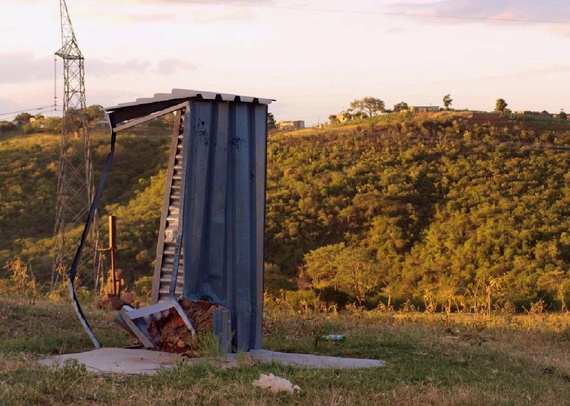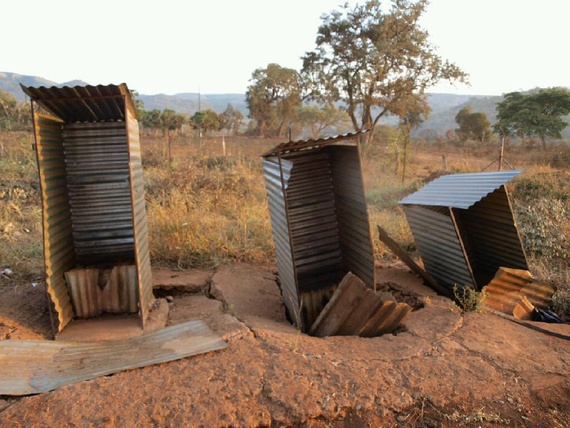
On that sanitation workhorse, the pit latrine, an Object Lesson

Zach Gershkoff
Growing up in an American town and attending first-world schools, I learned that an organism must have food, water, and shelter in order to survive. The need to eliminate waste did not make the list, possibly because there's nothing stopping your typical organism from doing so freely, and possibly because it's an unpleasant thing to dwell on. Looking back on my past experiences traveling, I have strong memories of sights and food and people but I don't have any vivid recollections of toilets. That changed when I was sent to South Africa with the Peace Corps. A good toilet performs its function and is easily forgotten, but a bad toilet stays with you.
Dealing with pit latrines is a common experience that unites Peace Corps Volunteers. Even though conditions and culture can vary greatly from country to country and village to village, something that we have in common is that we've all pooped in holes, and in general taken up another way of living than what we were born into. But for a significant percentage of the world's population, using pit latrines is done on a daily basis and indeed all they've ever known, not something that is simply done for a two year stint.
Statistics published by UNICEF show that 40% of the world's population does not have access to adequate sanitation. Not all pit latrines should be called inadequate, though, just the memorable ones. Although sometimes it can be hard to draw the line between adequate and inadequate, it's understood that for sanitation to be adequate, it must separate waste from potential human contact and preserve the dignity of the user. Digging a pit and building a structure over it is a cheap and effective way of doing just that. In South Africa, one initiative of the post-apartheid government that's hard to criticize is having the Department of Health construct pit latrines for rural households that previously had none.

Zach Gershkoff
Something that I've heard from Volunteers working in less developed African countries is that it can be hard to convince a rural population to use pit latrines rather than the even lower-tech open field. After all, it works for the cows. The reason given is that pit latrines smell bad, a fact which is unfortunately and immutably true. The smell can be mitigated by proper maintenance, but for all but the most infrequently used toilets, it is unavoidable. What's hard to teach, especially to a people who believe that witchcraft is a more likely cause for a disease than bacteria, is that waste in the open can contaminate food and water sources and lead to serious illness, particularly among children.
It would seem that collecting human waste in a pit would pose a health risk. After all, water comes from the ground. In places far from a city, such as my village, people can get water from communal taps built on street corners, but some families will also have boreholes drilled on their property for when the taps are dry, which they often are. Could it be dangerous to have a pit latrine too close to a borehole? Provided that it's properly maintained, no. A person with healthy kidneys is not going to pass more than a few liters of urine per day, so the flow of fluid into the pit should not be torrential. What doesn't evaporate may leech into the ground, but contaminants won't permeate far enough through the soil to reach the water table. Some pits will be lined with bricks or other casing for structural integrity, and it's not the end of the world if the lining develops cracks. For the most part, a user of a pit latrine will not know or care what, exactly, is under him.

Zach Gershkoff
Historically, inadequate sanitation has been a cause of infant mortality. Young children don't have the immune system to suppress waste-born diseases, and their growing bodies need the nutrients that diarrhea causes them to lose. The low infant mortality rate in the developed world owes as much to our sewer systems as it does to our doctors. But in homes with pit latrines, small children often don't use them. The seat is too high for them to climb, and then they risk falling in the hole. Instead, children are sent elsewhere to do their business and the waste is cleaned up afterwards (or not). At the crèche (preschool, borrowed from British terminology), where children below school age sometimes spend the day, there are properly sized latrines so the children can be well-trained for when they graduate to real school. It's sad to say that South Africa has a high infant mortality rate due to malnutrition and diarrheal infections. The rate has recently risen because of the HIV epidemic (and because infant deaths are less likely to go unreported nowadays). Every year, the crèche has a big graduation party. The five-year-old children who have survived the window of infant mortality are dressed in caps and gowns and treated to day-long festivities. It's the biggest event of their childhood.
The most deliberate thing one can do to ruin a pit latrine is to put in foreign objects that don't belong—a practice that's all too common due to confusion about how to use one properly. When my cohort of trainees arrived in South Africa, Peace Corps staff explained bucket bathing and our host families showed us how to wash clothes by hand, but we were left to our own devices to figure out the toilets. It's easy once you suppress the instinct look for a flush handle. I've heard tales of other Peace Corps Volunteers throwing bottles inside because they want to conceal from their family how much they drink, and I can only imagine that the pits are used to hide other inorganic waste where no one will look.
Essentially what you have at the bottom of the pit is a big compost heap. The bacteria already present will cook the fecal matter down, reducing its volume and its smell. This natural process is what allows the pits to last for years before they need to be drained. It doesn't need help, and it certainly doesn't need inorganic objects getting in the way and interfering with the biological cook, and potentially clogging the hose that's used to drain it.
Even with the best of intentions, adding something other than waste is a bad idea. Bleach and other cleaning chemicals will kill the bacteria doing the cooking, ultimately delaying the reduction of volume and making the latrine's smell worse for longer. Even water will make it so the waste can't decompose properly. A waterless toilet is great for communities where water is scarce, yet people continue to clean the bowls of their latrines by pouring in water because they don't know any better. Thousands of schools in South Africa own installations by Enviro Loo, a company that manufactures waste collection tanks designed to be environmentally friendly and easy to maintain. These tanks come with instructions to use a special enzyme instead of water or chemicals for cleaning. But, not everyone reads these instructions.

A sample Enviro Loo installation
If the environmental impact of a pit latrine used properly is so small, and if proper maintenance is so easy, sometimes I wonder why they haven't taken off in the developed world like composting food waste has done. Despite the savings in water (something you don't think about much until you can't get access to water) the sheer convenience of being able to “walk to privies in the rain and never wet your feet”, as Oklahoma puts it, can't be beat.
Other times, when I see the ceramic remnants of broken sinks and bathtubs, I wonder why my village exclusively uses pit latrines when it wouldn't be that hard to set up running water for a household. But, as anyone who works with technology in Africa can tell you, when things get broken there's no one to repair them. The beauty of the pit latrine is that there are no moving parts, so there's nothing to break. Things can't go wrong.
And yet things do go wrong. Most schools have two types of pit latrines on the property: modern, improved brick structures for the teachers, and ancient dilapidated stalls that are used by students if the school hasn't already retired them in favor of newer structures. The older toilets consist of rows of cubicle-style stalls with the doors fallen off, if indeed there ever were doors. Everyone deserves the privacy afforded by a door, and women in particular require it. Embarrassing toilet setups are an affront to dignity, but South Africans can tolerate these things with enviable serenity. The misplaced apathy towards undignified satiation is one reason that initiatives such as those funded by the Bill and Melinda Gates Foundation must devote energy to increasing the demand for sanitation, not just the supply of it.

Zach Gershkoff
Sometimes increasing demand involves something as simple and as low-tech as installing a door to a doorway. The metal door of my host family's pit latrine has twice fallen off its hinges, so the door and frame were punctured and fastened with wire on the opposite side, and then again when the wire tore through the holes. As a result, the door never closes all the way. It's actually kind of nice, because I can get a view overlooking the families' corn field and a distant road while sitting inside.
In this case, the major drawback of having a door that can't close is that light gets inside, and flies are drawn to light as much as to the smell of feces. The upshot is that a pit latrine of moderate use and moderate disrepair, such as my host family's, can become host to a fascinating study of biology.
Where there are flies on a semi-permanent basis, you can expect lizards to be crawling around the walls, and perhaps toads hoping to catch a meal. There's also a spider or two waiting for prey in the corners. I've witnessed ants and roaches timeshare the cracks around the toilet seat, with ants seeming to fare better in the colder months. The capstone of the pit latrine ecosystem is the bat. A family of bats will sometimes claim a lucky pit as their cave, and as much as I appreciate what bats do to kill flies and mosquitoes, discovering a bat under your bare posterior can be traumatizing.
But all of these troubles can easily be avoided! There's a clever engineering solution called the ventilated improved pit (VIP) latrine that averts the flies and mitigates the smells. It's really very simple, and even the fanciest pit latrines follow this basic design. The defining feature of VIP latrines is a black PVC pipe coming up from the pit in the back. The pipe extends past the roof, allowing bad smells to rise above and blow away in the wind. At the top of the pipe is a fly screen. Any flies that manage to get inside will be drawn towards the light, and as long as the door or lid is intact and closed, light will only emanate from the pipe, not from the seat. Thus the flies will get trapped and die and fall down and decompose with everything else in the pit.

Enviro Loo installation instructions
We treasure our modern toilets. For those of us who have been lucky enough to grow up with them, anything less seems both revolting and uncivilized. But a well-built room and a little care is all it takes for people around the world to have completely forgettable experiences at the loo. A pit latrine may not put human waste out of sight and mind quite as thoroughly as a modern toilet, but it can be just as safe and dignified.